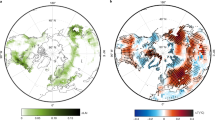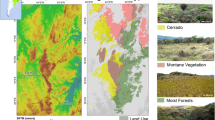Summary
The leaf area index (LAI) is one of the most critical variables describing the biophysical and biochemical properties of the land cover in the remote sensing and climate models. In this study, the climatological variations of LAI is analyzed with NOAA’s 14-year (1981–1994) Advanced Very High Resolution Radiometer (AVHRR) measurements. More attention is given to the 14 months of Julys or the warm seasons, in which interannual LAI variations contain more pronounced signals of dynamic forcing associated with the tropical rainforests and the temperate forests around 60° N. Furthermore, projecting the LAI anomalies into the empirical orthogonal function time series of El Niño and other climatologically important events shows that the large-scale circulations play an important role in determining the interannual variations of LAI, likely through the changes of surface insolation, precipitation and soil moisture. It is found that on the global scale LAI and the land surface and skin temperatures are negatively correlated, namely, decreasing LAI corresponds to warm temperatures. However, the regional LAI effects on the land surface climate vary significantly from regions to regions.
Similar content being viewed by others
Author information
Authors and Affiliations
Additional information
Received October 13, 2001 Revised December 28, 2001
Rights and permissions
About this article
Cite this article
Jin, M., Zhang, DL. Observed variations of leaf area index and its relationship with surface temperatures during warm seasons. Meteorol Atmos Phys 80, 117–129 (2002). https://doi.org/10.1007/s007030200019
Issue Date:
DOI: https://doi.org/10.1007/s007030200019




